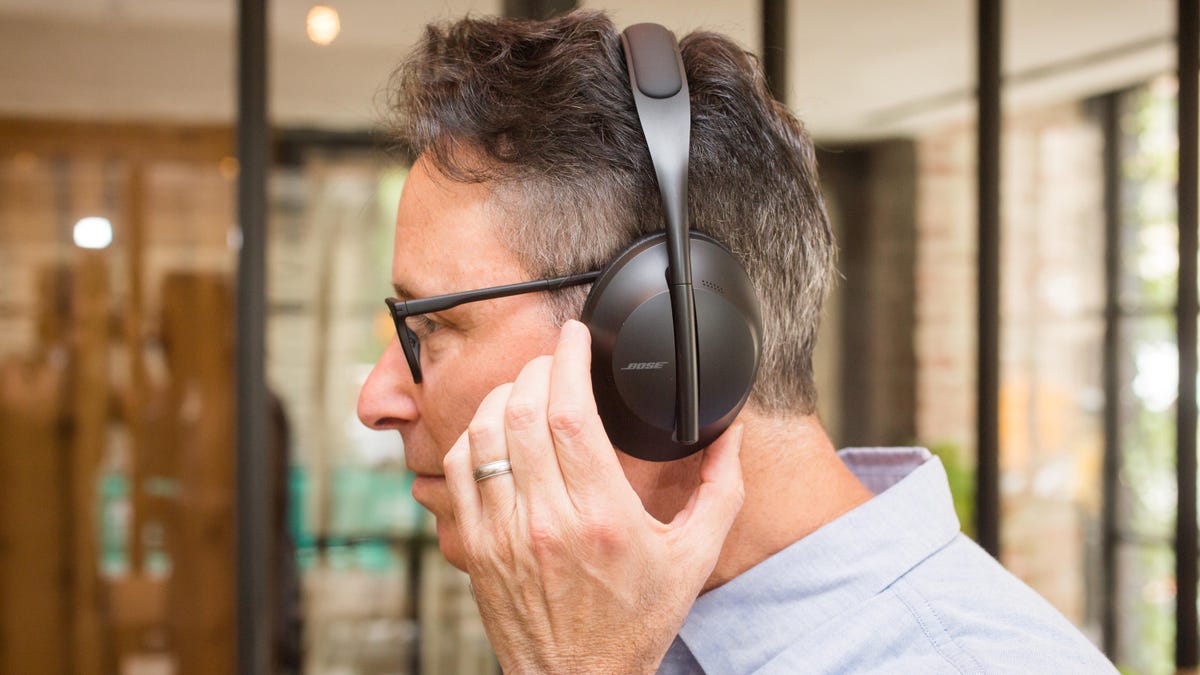
Our Experts CNET’s expert staff reviews and rates dozens of new products and services each month, building on more than a quarter century of expertise. What to consider Budget It's important to know how much you want to spend before you start searching. Microphone Do you want a boom microphone sticking out of the side of your headset, or something that could be used in more places than just your desk if it meant the microphone wasn't as good? Comfort You should be able to wear your headphones all day without pain or awkwardness.
Durability If you're going to spend this much money, you should know it'll last a while. Return policy Where you buy from is almost as important as what you buy, just in case you need to try out a different headset. Our Picks CNET’s expert staff reviews and rates dozens of new products and services each month, building on more than a quarter century of expertise.

What to consider Budget It's important to know how much you want to spend before you start searching. Microphone Do you want a boom microphone sticking out of the side of your headset, or something that could be used in more places than just your desk if it meant the microphone wasn't as good? Comfort You should be able to wear your headphones all day without pain or awkwardness. Durability If you're going to spend this much money, you should know it'll last a while.
Return policy Where you buy from is almost as important as what you buy, just in case you need to try out a different headset. What's the best headset or headphones for your home office? Working from home is great but comes with its own set of challenges. If you don't live alone and find yourself facing distractions throughout the day, investing in a good headset will help.
Whether you need the perfect companion for your online meetings or one to block out interruptions, we've found the best headphones for working at home. As the trend has shifted to remote and hybrid work, I've found myself testing many different headsets. We evaluate headphones for home use based on call performance (especially background noise reduction), comfort and music audio quality.
Other features we consider include active noise cancellation, battery life and multipoint Bluetooth pairing. The latter lets you connect to two devices simultaneously, which can be very convenient for switching between devices you use for work. Read more : Best Earbuds for Phone Calls for 2025 You might be looking for headphones designed to work with Unified Communications applications, certified for Skype for Business, optimized for Microsoft Lync and compatible with Cisco, Avaya and Skype softphones.
I've included some UC headphones on this list, but most of them are mainstream consumer headphones that also work well on the go. Best headsets and headphones for working from home of 2025 Not to be confused with the earlier Jabra Evolve2 65, the Evolve2 65 Flex has a slimmer design with dual hinges that allows you to fold the headset up flat in its compact carrying case. While this is an on-ear headset, it has a nicely padded headband and earpieces and is impressively comfortable (it also helps that it's relatively lightweight, weighing 136 grams or 4.
8 ounces). I was impressed with the sound and performance of the Evolve2 65 Flex. It has a retractable boom microphone and good active noise canceling along with excellent noise reduction for calls (I made calls in the noisy streets of New York and callers said I sounded clear with little background noise intrusion).
Flip the boom mic up and you automatically get muted during video conference calls. Flip it down and you unmute yourself. With 28mm drivers, this headset also works well for listening to music and other audio, which is what you should expect for its high price tag.
It only supports the SBC audio codec and not the superior AAC or aptX audio codecs (that's not the end of the world, but it is worth pointing out). Equipped with Bluetooth 5.2, you can connect it to a variety of devices wirelessly and the included Bluetooth USB-A dongle allows for easy pairing with PCs (you can connect it to two devices at the same time).
Finally, battery life is rated at up to 21 hours with noise canceling on and 32 hours with it off. That's decent for a compact headset. Logitech's second-gen Zone Wireless 2 headset improves on the original with an upgraded design and performance.
This is an on-ear model that competes with Jabra's Evolve2 65 Flex but is a bit heavier (230 grams) and has some metal parts (the headset feels both substantial and sturdy with a premium look). It is comfortable to wear for long periods with soft ear pads filled with high-quality memory foam. Like the Jabra, this Logitech has a retractable boom microphone with a mute button on it.
It also has active noise cancellation and I thought it did a good job muffling external noise and reducing background noise when I was on calls. You can also toggle on a transparency mode that lets you hear the outside world. The headset is equipped with five microphones and uses Bluetooth 5.
2 with a wireless range of 50 meters, which is much better than the typical 10-meter range of Bluetooth. Battery life is rated at up to 15 hours with noise canceling on and 18 hours with it off. People were impressed by how clear I sounded on calls, even when I tested the headset in the noisy streets of New York.
Sound quality has also improved, and while this doesn't sound as good as Sony or Bose headphones, the sound quality for listening to music is quite respectable. It supports the SBC, AAC and AptX audio codecs (Jabra Evolve2 65 Flex only supports SBC). The white version I tried was Microsoft Teams certified and came with a USB-A/USB-C Bluetooth dongle for computer use and a slim carry pouch.
In all, this is a nice upgrade over Logitech's Zone Wireless Headset and a top headset. A few years ago Shokz turned its OpenRun (formerly Aeropex) bone-conduction headphones into a more communications-friendly headset with an integrated boom microphone called the OpenComm ($140), which remains available. The second-generation OpenComm 2 UC costs more than the original, but it has an upgraded Bluetooth 5.
1 chipset that improves performance a bit and now allows for the firmware upgrades that are required for Zoom certification. Additionally, the microphone has moved from the left ear to the right and a convenient mute button has been added to the boom microphone, an important addition. Since these leave your ears open — the sound is conducted through your cheekbone — they aren't for people who want to seal their ears out from outside noise.
Rather, the idea is that you can hear everything around you without having anything covering your ears or jammed inside them. The headset is quite comfortable to wear. Some folks find that liberating and these do feature excellent noise reduction for calls, as callers told me they heard very little background noise even when I was out on the noisy streets of New York.
While the Shokz are arguably the best-sounding bone-conduction headphones, they aren't great-sounding for music because they're lacking in the bass department. But they're great for speech, so they work very well as a headset for making calls and listening to podcasts or audiobooks. These also have multipoint Bluetooth pairing, so you can pair them with your phone and PC and easily switch to your phone if a call comes in while you're on your computer.
They come with either a USB-A or USB-C wireless dongle (you choose) that you plug into your computer for quick and reliable wireless connectivity. As long as you don't mind the boom microphone, you can use the OpenComm 2 for sporting activities as well and it's our favorite for runners who want to keep their ears open to hear the outside world for safety reasons. They're also water-resistant.
The only downside is they require a proprietary charging cable instead of USB-C. Battery life is rated at 16 hours of talk time and 8 hours of listening. When you have a product that a lot of people love, change can be risky.
Such is the case for Sony's WH-1000XM5, the fifth generation of the 1000X series headphones, which were first released in 2016 as the MDR-1000X Wireless and have become increasingly popular as they've improved with each generation. Over the years, Sony has made some tweaks to the design, but nothing as dramatic as what it's done with the WH-1000XM5. Other than the higher $400 price tag ($50 more than the WH-1000XM4), most of those changes are good, and Sony's made some dramatic improvements with voice-calling performance, as well as even better noise canceling and more refined sound.
SCORE Apple not only swapped in USB-C for Lightning connectivity in its new iPhone 15 models, but it made the switch with the AirPods Pro (second generation). The new AirPods Pro 2 with MagSafe (USB-C) are nearly identical to their Lightning predecessor, delivering the same excellent sound, noise canceling and voice-calling performance. That said, they offer some other small upgrades, including additional dust resistance and a new acoustic architecture that allows for Lossless Audio with the Vision Pro , Apple's newly-released wearable headset that costs $3,499.
Is it possible that new acoustic architecture makes the buds sound subtly different with current devices like the iPhone? Maybe, maybe not . Either way, the AirPods Pro 2 (USB-C) are easy to recommend to Apple users despite their high price. SCORE Bose's new flagship QuietComfort Ultra Headphones may not be a huge upgrade over the company's Noise Cancelling 700 headphones, but they feature a more premium design along with Bose's new Immersive Audio feature, which delivers some sound-quality enhancements.
Along with excellent sound and great noise canceling, the QC Ultra Headphones are also superb for making calls, with top-notch background noise reduction. All that adds up to the best noise-canceling headphones of 2024 and is a worthy adversary to Sony's highly rated WH-1000XM5 and Apple's AirPods Max. SCORE There's a lot to like about Logitech's Zone Vibe 100 wireless over-ear headset, which comes in off-white, carbon and rose colors.
For starters, it's lightweight and comfortable to wear, with a retractable boom microphone you can flip up to mute. It also has a mute button on it. It also includes multipoint Bluetooth pairing, so you can pair it simultaneously with your Mac or Windows PC and your smartphone and easily switch audio back and forth between the two devices.
These aren't active noise canceling headphones but they offer a decent amount of passive noise isolation. Battery life is rated at up to 20 hours of listening time. People said I sounded clear on calls and there's some sidetone, so you can hear your voice in the headphones as you talk (that way you don't end up raising your voice too much).
I thought they sounded good while listening to music on my phone. The sound quality wasn't quite up to the same level when streaming Bluetooth audio on my computer, though it was still decent. The Logi Tune app for iOS and Android does allow you to tweak the sound profile, adjust the sidetone and set when the headset goes to sleep when not in use.
Like JBL's Tour Pro 2 earbuds , the Poly Voyager Free 60 Plus UC earbuds also have a touchscreen display embedded in their charging case. The display isn't quite as fancy as the one on the JBL case (it's mostly monochrome), but these are among the first earbuds to have a case with a mini control panel integrated into it. Additionally, the Free 60 Plus UC case also turns into a Bluetooth transceiver for inflight entertainment systems (you plug the case into the 3.
5mm headphone port). I also liked how you can store the USB-A Bluetooth dongle in the charging case when you're not using it with your computer. Aside from the tricked-out case, the big strengths of the Poly Voyager Free 60 are the comfortable fit, excellent voice-calling performance for video calls (they have a three-mic array in each bud), solid noise canceling and very good sound quality.
Equipped with 10mm drivers, they might not offer quite as good sound quality for music as other premium earbuds in this price range, but there's good depth and punch to the bass, decent clarity and they have a pleasant sound profile overall. They support the AAC and AptX audio codecs as well as LC3 when making video calls, Poly says. Battery life is rated at up to 5.
5 hours with noise canceling on. I was able to easily switch between using the buds with my computer (with the USB dongle) and my iPhone. While they worked well for making cell phone calls indoors and outdoors in quieter environments, callers said they could hear a good amount of background noise when I was making calls in noisier environments.
Poly says it's working to improve noise reduction for cell phone calls with a firmware update later this year. The earbuds can be updated via the Poly Lens app for Desktop, iOS or Android that also features a variety of settings you can play around with. Note that these earbuds are available in a non-UC version with a standard charging case for $200 or $100 less.
Plantronics' original Voyager Focus UC has long been considered one of the best work-from-anywhere headsets. Now we get the Voyager Focus 2 UC from Poly (the company Plantronics morphed into after it acquired Polycom), and it's improved in several ways, including better noise reduction (it's stellar), two levels of active noise canceling, increased battery life (up to 19 hours with ANC off and 16 hours with it on) and superior wireless range with Bluetooth 5.1.
You can pair the Voyager Focus 2 UC with your computer with the included USB dongle or your phone (or tablet) via Bluetooth. It can also connect to a desk phone if you want to bring it to the office. Also worth noting: The boom microphone has a mute button on it, but when you flip it up it also automatically mutes the microphone.
The original Voyager Focus doesn't mute when you lift the boom microphone. The Focus 2 comes in several different versions, including USB-A and USB-C models and a version that's Microsoft Teams certified. You can get the headset by itself or in a bundle that includes a charging dock.
All versions include a nice protective carrying pouch. The Voyager Focus 2 UC is expensive but offers excellent performance and is quite comfortable for an on-ear headphone. It also sounds good for music listening with nicely detailed sound and ample bass.
It may not be quite up to the level of the Sony WH-1000XM5 for music, but it offers a nice music-listening experience for a work-centric headset. There's a bit of a generic look to Kensington's H3000 headset, but it's comfortable to wear with a nicely padded headband and ear cups, and it seems well built. Featuring a rotating boom microphone that can be worn on the right or left side (there's no designated left or right ear cup), the H3000 also offers good performance with decent sound for music listening and clear voice quality, according to those I spoke with (the microphone flips to mute).
There's no active noise canceling — just noise reduction for calls — but the ear cups do passively seal out a fair amount of ambient noise. The headset uses Bluetooth 5.2 and has excellent battery life: It's rated for up to 60 hours of music listening and 40 hours for calls.
It also has multipoint Bluetooth pairing, allowing you to pair it two devices simultaneously (your computer and smartphone, for example) and Kensington says it's designed for use with Intel Evo laptops but works fine with other laptops as well. Sony's improved entry-level noise canceling headphones, the CH-720Ns, have a bit of a plasticky budget vibe, but they're lightweight and very comfortable. Part of me was expecting them to sound pretty mediocre, but I was pleasantly surprised.
No, they don't sound as good as the WH-1000XM5s. They sound more premium than they look (and feel), and their overall performance is a step up from their predecessor, the CH-710Ns. Are they worth $150? Maybe, or maybe not.
The good news is that, like the CH-710N and WH-XB910 before them, these have already seen significant discounts, with prices dropping to as low as $100 during flash sales. SCORE If you're looking for a souped-up version of Jabra's Elite 85h headphones, which came out a few years ago, the Evolve2 85 offers even better telephony options along with a Unified Communications USB dongle for PCs. It has similar sound quality to the 85h, it has an updated audio chipset, a hideaway boom arm and two additional microphones (10 altogether, with the extra two in the boom arm) for noise reduction and picking up your voice.
Its build quality is also a step up. A Microsoft Teams-certified version is available for those who need it. I found it comfortable to wear over several hours, and it offers an impressive 37 hours of battery life or slightly more than the Elite 85h.
If you're an Apple-centric person who works on a MacBook and also has an iPhone (and maybe an iPad), Apple's AirPods Max noise-canceling headphones allow you to easily connect to multiple Apple devices simultaneously (so long as you're signed into your iCloud account on all the devices) and switch between them. If you're on a Zoom teleconference and a call comes in on your iPhone, the AirPods Max automatically switch to the iPhone if you pick up the call. They sound great, and with all their microphones they do an excellent job picking up your voice and reducing ambient noise.
Aside from their high price, their other potential downside is their heavy weight. Although I found them comfortable, some people have trouble with that. SCORE UC headsets that include a USB dongle so you can easily connect the headset wirelessly to your computer tend to cost more than headsets that just feature Bluetooth connectivity.
Listing for around $130, the Cyber Acoustics Essential Bluetooth Headset HS-2000BT sells at a discount compared to similarly styled models from Jabra and Poly. I'm not going to say the HS-2000BT is better than those models, but it's lightweight and comfortable to wear and offers similar features, including a retractable boom microphone with automatic muting (when you retract the boom mic). It also has a couple of bonus features: active noise canceling and wireless charging (Qi wireless charging pad not included).
Callers said I sounded good though not quite as clear as when I was using the Logitech Zone Vibe 100. I thought the HS-2000BT sounded good when using them to listen to music, though the sound is on the warmer side (pushes the bass a bit). The headset is worth checking out, particularly if it goes on sale.
Jabra's Evolve2 30 is a wired on-ear office headset with an integrated boom microphone. It's lightweight and comfortable and comes in USB-C and USB-A versions, as well as stereo and mono versions (I tried the USB-A stereo version). The headphones are decent but not great for music listening, but they're primarily meant for voice applications.
They feature dual microphones: one for picking up your voice and the other to help reduce the ambient noise around you so callers can hear you better. Known for its value headphones and earbuds, JLab offers a pair of on-ear headphones with an integrated boom microphone (it can be rotated up when just listening to music) and multipoint Bluetooth pairing so you can connect them to your phone and computer simultaneously. JLab's Go Work headset may not be great, but it delivers better-than-expected performance for a modest price.
They're also comfortable to wear with a lightweight design. You won't mistake these for premium headphones, but the build quality means that they are among the best headphones for work for around $50. Battery life is rated at up to 45 hours at moderate volume levels, and you can mute calls using the multifunction button (an LED lights up at the end of the boom mic when the call is muted).
I wouldn't call the sound quality for music listening and the headset performance stellar, but it's decent, particularly for the price. For music listening, there's ample bass and clarity and a cable is included for wired use. The headphones charge via USB-C.
Note that JLab also sells over-ear Go Work headphones that cost around $80 and do sound a little better. Factors to consider when buying a headset Before anything else, you'll want to figure out how much you're willing to spend on a new wireless headset. The quality of value-priced headsets continues to improve, so you can find good affordable headsets and headphones for less than $100.
The premium models, which offer better build quality and performance, tend to cost $200 or more, and sometimes much more. When a headphone has a boom microphone, that's when it technically becomes what we describe as a "headset." Many consumer headphones work well for making calls, having an extended microphone that sits closer to your mouth can improve how well your voice gets picked, making it sound clearer.
When retracted, some boom microphones will mute the headset so people can't hear you. Some boom mics now feature mute buttons on them. This is an important feature for video calls where you want to easily mute and unmute yourself.
The downside to having the boom microphone is that it makes you look like you're wearing a headset instead of headphones. That's a bit of a factor if you plan on wearing whatever you buy outside your home or office. It's key that the headset or headphones you buy fit your head well.
They should offer a comfortable fit that's snug yet not too snug. Ideally, you want a headset of headphones you can wear over the course of a day with minimal breaks. You want headset that hold up well over time, so look for models that we note have sturdy build quality.
It's critical to buy your headphones at a retailer that has a good return policy, in case you have buyer's remorse. Some people who are having trouble deciding between two models sometimes buy both, try them out for a few days, and then return one. How we test headphones and headsets for working from home We test headphones and headsets based on six key criteria.
These criteria include design , sound quality , noise canceling performance , voice-calling performance, features and value . Testing call quality on the streets of New York. Other headsets we tested Plantronics Voyager Focus UC : After Plantronics became Poly, it released a new version of this oldie-but-goodie headset called the Voyager Focus 2 (see above).
This model remains on sale. We are steering people toward the newer model. Home office headset and headphones FAQs The benefit of a boom microphone is that it extends out, which puts it closer to your mouth and makes picking up your voice easier.
Some headphones and earbuds with beam-forming microphones do a very good job of picking up your voice, but a good boom microphone is often the superior option. The only downside is that unless it truly retracts and is able to blend into the headphone's design when retracted, it makes the headset less attractive as a standard headphone for mobile use. Yes.
Many gaming headsets have retractable microphones and are designed for chatting online with fellow gamers. That makes them good for video-conferencing apps but not everybody likes how they appear wearing a gaming headphone for a business call. People tend to look better wearing small earbuds than full-size headphones.
It's really just a matter of personal preference. The one downside to earbuds is that they usually have far less battery life than full-size headphones, so you'll probably have to charge them during a break to use them for an entire day..











